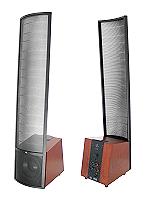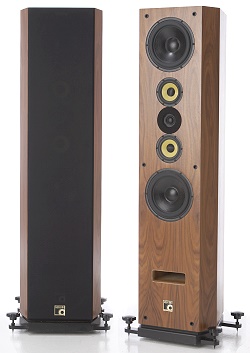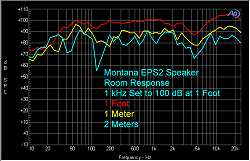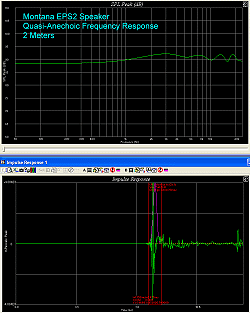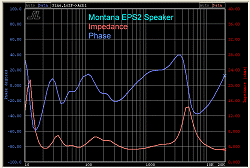Introduction
Montana Loudspeakers, marketed by PBN Audio, is a company whose products I have been very interested in for a long, long time. I have seen them at numerous hi-fi shows, and since I have two massive 1,200 watt monoblock power amplifiers that I like to pair with massive speakers once in awhile, I have been attracted to the Montana’s, partly because the line includes some really big models. But more importantly, they have always impressed me with the sound quality at shows – which is not easy to do because the rooms are less than ideal – and they are incredibly beautiful.
For this review, really there was no way I could get their top of the line model, the WAS, because each one weighs almost 400 pounds. It was just not feasible.
So, in corresponding with Peter Noerbaek, president of PBN Audio, we decided that the mid-level EPS2 would be most appropriate for a first look at the Montana line. Also, the EPS2 is a new update of the EPS.
Specifications
- Design: Three-way, Ported
- Drivers: One 1″ Fabric Dome Tweeter, Two 4″ Midrange, Two 9″ Woofers
- MFR: 20 Hz – 22 kHz
- Sensitivity: 92 dB/2.83v/M
- Nominal Impedance: 4 Ohms
- Crossover Frequencies: 225 Hz, 3 kHz
- Power Handling: 300 Watts
- Dimensions: 53″ H x 15″ W x 15″ D
- Weight: 135 Pounds/Each
- MSRP: $10,000/Pair USA
- PBN Audio
And so, they arrived.
The Montana EPS2’s came to the lab in two large boxes, and I mean large. As we grunted and groaned to move them into room and position them, I was glad only to have to deal with 135 pound enclosures.
The review units had Rosewood veneer, and the construction was superb. Notice in the photo below how the edges are flawless. Sharp metal spiked feet attach to horizontal metal strips for decoupling the floor.

Drivers include a 1″ fabric dome tweeter, two 4″ midrange drivers, and two 9″ woofers, mounted in a WMTMW arrangement. The woofers and midrange drivers have their own internal enclosures to keep their air pressure changes from affecting the other drivers. The woofers are slot-loaded, with the slot near the bottom of the enclosure.
The tweeter has a felt ring surrounding it, to absorb sound that would otherwise be reflected from the front of the enclosure and cause diffraction. The second photo shows a close-up where you can see the weave of the fabric dome.
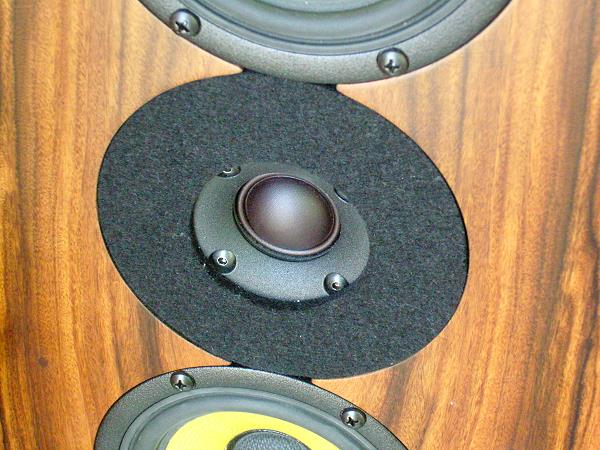
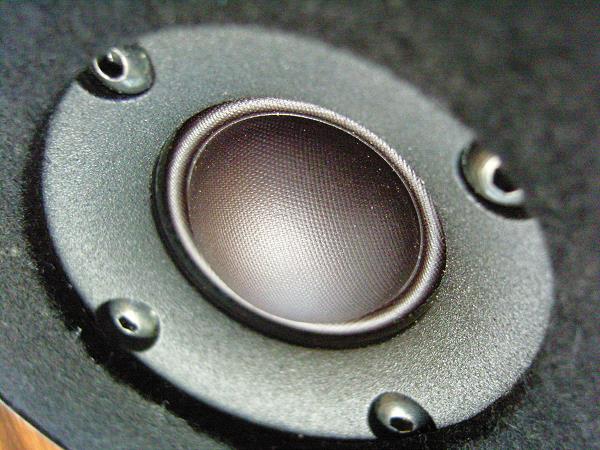
On the rear of the enclosure are two pairs of heavy binding posts. The speakers are intended to be bi-wired, so no bus bar strips (for connecting the tweeter posts to the woofer posts) are included. I made some from solid core conductors and put them in. The right side posts are the +.
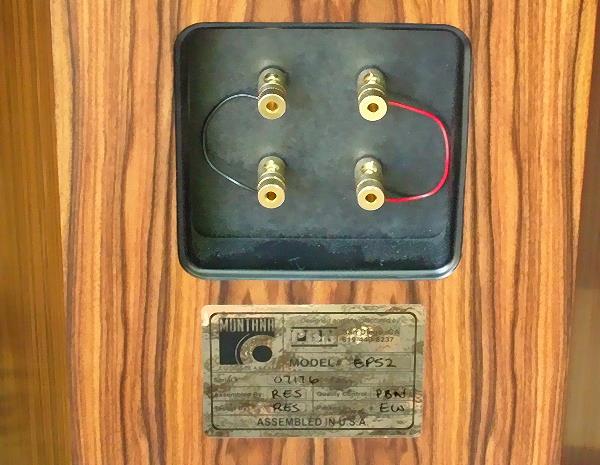
In Use
I tested the EPS2’s with a McIntosh MCD-201 SACD player, McIntosh MT10 turntable with Clearaudio MC cartridge, Manley Labs Steelhead phono stage, Musical Surroundings Phonomena phono stage, Bryston BP-1.5 phono stage, BAT VK-5i preamplifier, and McIntosh MC-1201 power amplifiers. Cables were Legenburg and Nordost.
I placed the speakers several feet out from the rear and side walls, toed in slightly.
As many of you know, I am writing a running commentary on Vinyl vs. CD. While working on that article, I have been testing a variety of equipment coming through the lab, including the phono stages mentioned above, but also some amplifiers and speakers. The Montana EPS2’s fall into that category.
The Montana’s are truly spectacular speakers, as evidenced by the sound I was experiencing during all the testing of various phono stages. In particular, I just could not stop playing the following two albums over and over (I listened to about 20 albums using the Montana EPS2’s).
The first one is an album that my girlfriend at the time (1964) purchased for me as a Christmas present. It must have impressed me, as I married her upon graduation in 1968 ;=>. Anyway, the album is a 1961 recording of Tchaikovsky’s Romeo & Juliet, with Charles Munch conducting the Boston Symphony Orchestra. At that time, of course, we had LPs. Digital was not even a word in anyone’s vocabulary yet. We had heard this album in a music class at the University of Washington. I just loved it, so Susan got one for me. It was my first classical music album, and I was hooked from that point on.

This particular recording is a masterpiece, and has been re-issued several times. One was on CD, which I purchased a few years ago (JVC JMCXR-0022), but the other is a recent re-issue on 200 gram vinyl, a.k.a., an LP.
When CDs first came out, I gave away nearly all my LPs. Of course, I have since regretted doing that, so it is difficult to put into words how excited I was to hear this album on vinyl again after all these years. This was especially so, as in those days, I did not have anything like I do now in terms of audio equipment, including the advanced turntable and cartridge technology that is now available.
I had not been all that happy with the CD version, because there seemed to be something missing. And I am not talking about distortion. It just did not have the intimate liveliness that I had remembered from the LP version.
So, when I put the Tchaikovsky LP on the McIntosh MT10 a few weeks ago, I was mesmerized. All the subtle detail and nuance that I had experienced more than four decades ago returned . . . and then some. I sat transfixed.
No, the orchestra did not sound like it was in my room. I have discussed this before, and it really is not possible to make a symphony orchestra sound that way with any audio system I can think of. But, the goose bumps were there, as before. The violins had the intimate quality that I had missed so much. But, unlike listening to the small system I had back then, the Montana EPS2’s added dynamics that I had never experienced in the old days. Every instrument was full of detail, including the rosin, as well as the performers’ breathing. Finally, I was able to crank things up to a level that caused me to perspire heavily, as if I were one of the performers belting out this astonishing music. One of the advantages of a large speaker with so many drivers is that it will play loud, with less distortion. That is what I wanted from the EPS2’s, and that is what I got. No harshness, no mush, no boominess. Just music.
I did notice that the Montana’s are rather directional, at least vertically. That is something which occurs when there are multiple drivers delivering the same signal, i.e., two midrange cones one hear the other. If you stand up, the signal from the lower driver is a bit farther away from your ears than the upper driver, so there is some cancellation. But, the tweeter and mids are mounted at just about ear height when one is sitting down, so it’s not a problem when listening in a chair.
The second album I want to talk about here is a re-issue of Miles Davis’ Kind of Blue. This is a recording that is even older than the Romeo & Juliet album, but it is apparently the best selling jazz album ever released. So, I ordered it in LP, SACD, and CD versions to work with in the Vinyl vs. CD article.
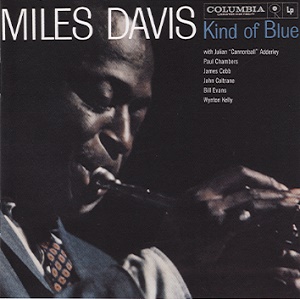
Besides Miles Davis, the group on this album included Cannonball Adderley, John Coltrane, and Bill Evans.
The soundstage on this music with the Montana speakers was just unbelievable. Again, it’s difficult to describe. Being a percussionist myself, I am very sensitive to overly sibilant cymbals, which can be caused not just by tweeters, but by the CD player, preamp, and the power amplifier. But, the EPS2’s blended beautifully with all the other outstanding components in the system, and what I heard was about as close to a real cymbal as could be imagined. If you are a drummer, you know exactly what I mean, but for all the rest, this is a very, very difficult instrument to reproduce without too much sibilance because it has lots of intense high frequencies.
For both these albums, I preferred the sound of the LP over the digital recordings, and I will discuss this in the Vinyl vs. CD article at some point.
On the Bench
Distortion tests used an 80 kHz bandwidth.
At 1 kHz, 100 dB, and 1 foot, THD+N was less than 0.3%, primarily third order. The signal was coming from the midrange drivers, but since the mids and woofers were in pairs, I kept the calibrated microphone in the same position for all the distortion measurements, i.e., directly on-axis with the tweeter.
At 10 kHz, distortion was less than 0.8%. In this case, the signal was coming from the tweeter.
For THD+N vs. Frequency, the EPS2’s performed admirably. Notice that the distortion in the lower frequencies competes well with a dedicated subwoofer. Distortion stays generally well below 1% from 100 Hz up through 20 kHz. Overall, quite excellent.
Room response was all over the place depending on distance from the microphone. This is because there are multiple drivers emitting the same signal, and is one of the drawbacks of multiple tweeters, midrange drivers and woofer drivers. However, the benefits are a much larger soundstage and the ability to play intense music at higher SPL without too much distortion.
The quasi-anechoic response showed this same tendency. Note the dip at 4-5 kHz which is reflected in the room response as well. It is not a big deal. Just something a purchaser of big speakers needs to be aware of. The impulse response measurement used a window of 0.75 ms, so it is accurate only above about 2 kHz, which is the region I was interested in for this comparison.
The impedance/phase curves show that the EPS2’s are truly a 4 ohm load. The phase stays within ± 400 between the usable range of 20 Hz to 20 kHz, so this should not be a problem with most amplifiers.
Conclusions
Well, I have to say, “WOW!” I certainly was not disappointed with my first in-lab experience with Montana loudspeakers. They are beautifully constructed with the highest quality parts, and the sound is definitely “dynamite”. As the ESP2’s are just the mid-level model in their line, I can only imagine what something like the WAS would sound like.


